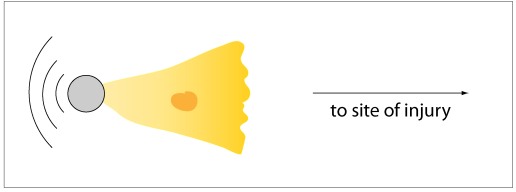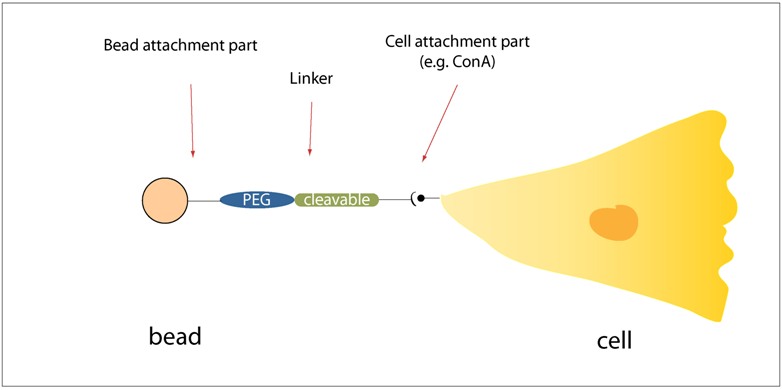Team:UCSF/PAYLOAD
From 2009.igem.org
Making Engineered Cells carry a PAYLOAD
Motivation: Why is this useful?
Once a cellular robot has detected and traveled to a site of disease in the human body, it should be able to perform a useful therapeutic task. One simple but very useful task that we envision our cells performing in the body is the targeted delivery of drugs or signaling molecules to diseased areas. This would be useful in the delivery of all sorts of substances to targeted areas in the body. Some examples include: 1) cases where a drug is toxic and off-target side effects are dose-limiting (e.g. chemotherapeutics used for cancer), 2) cases where precise delivery of a contrast agent to diseased areas would aid in diagnosis (e.g. sites of cancer metastasis), 3) cases where localized delivery of a specific bioactive molecule to a site would be therapeutically beneficial (e.g. delivery of specific growth factors to areas of wound healing and regeneration).
Toward the end of engineering our cellular robots to carry useful cargos, we designed and began testing a generalizable scheme for tethering fluorescent polymer microspheres ("beads") to the outside of our cells.
Approach
We designed a modular and generalizable scheme for attaching fluorescent polymer microspheres to the outside of our cells. To make the approach modular, we thought of our strategy as having three main interchangeable parts: 1) Bead attachment part, 2) Linker, 3) Cell attachment part. By ensuring that we make the parts interchangeable, we made the approach generalizable. For example, changing out the cell attachment part for a different one would allow us to attach beads to a different type of cell. Likewise, we could use different types of linkers including photocleavable or enzymatically cleavable ones. Changing out the bead attachment part could allow us to attach not only beads but other cargos to cells.
Some important early considerations for us were therefore: 1) Best to use a scheme that does not require much (or any) genetic manipulation, so that we can use our scheme quickly and easily with any cell or cell type, 2) Use well-established chemistries and reagents, 3) Be able to swap and interchange modular parts.
For our pilot experiments this summer, we used the simplest possible parts that we could think of. For cellular attachment, we used the jack bean lectin protein Concanavalin A (ConA), which binds mainly to internal and nonreducing terminal alpha-mannosyl groups. We left the linker out in some cases, though in others we used polyethylene glycol (PEG) linkers. For bead attachment, we used either streptavidin-biotin chemistry, passive adsorption of protein on the surface of polystyrene beads, or carbodiimide chemistry with the crosslinker EDC.
To observe the cells, we coated glass-bottomed Lab-Tek II Chambered Coverglass slides with fibronectin, adhered cells to the slide, and then incubated with varying concentrations of modified beads followed by a wash step. We then visualized the cells using time-lapse microscopy.
Results
We have been able to observe our cells exhibiting motility while tethered to "cargos" of fluorescent beads. Below are two representative movies, each taken using fluorescent beads with ConA (no linker). Frame rate is 15 seconds (real time) per frame.
Here are some stillshots from the movies.
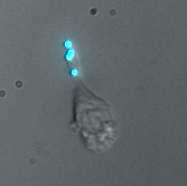
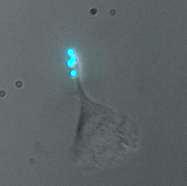
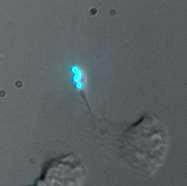
Summary and Outlook
We have shown that we can tether simple fluorescent bead "cargos" to our cells. We are using a simple, generalizable, and modular scheme to attach these cargos, and we will continue to try different attachment and linker parts to improve on our initial result. Some things we are working on include efficiency and robustness of attachment and internalization of beads by cells.
We would also like to explore the ability of cells to carry larger bead cargos and different types of cargos (non-bead). In addition, we would like to study the physical limitations of these cells in carrying cargo. For example, it would be particular interesting to determine whether the cells can carry carry cargos through complex environments such as three-dimensional hydrogel environments, endothelial cell monolayers, and more.
Methods
Payload:
- Binding concanavalin A to beads
- Attaching beads to cells and observation using time lapse microscopy
Selected Reading
Microoxen: Microorganisms to move microscale loads. Weibel DB, Garstecki P, Ryan D, DiLuzio WR, Mayer M, Seto JE, Whitesides GM. PNAS August 23, 2005 vol. 102 no. 34 11963-11967.
| Home | The Team | The Project | Parts Submitted to the Registry | Our summer experience | Notebook | Human Practices |
|---|
 "
"
